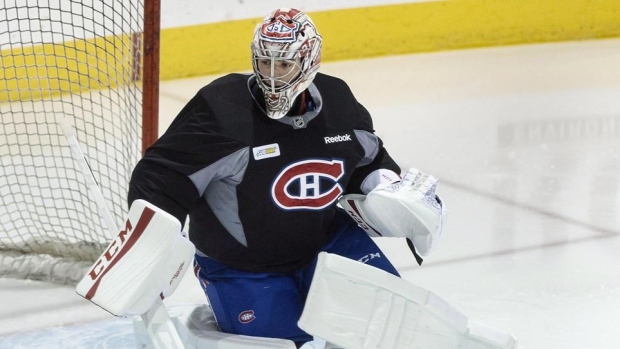Aug 30, 2016
Goalie equipment change unlikely before 2017-18
NHL goalies won't look as trim as expected this season because of delays to an ambitious redesign of their bulky equipment.
The Canadian Press

NHL goalies won't look as trim as expected this season because of delays to an ambitious redesign of their bulky equipment.
NHL officials at the general managers' meetings in March said the league and the NHL Players' Association were planning to introduce equipment more befitting of a goaltender's actual size this fall, perhaps even in time for the World Cup of Hockey.
Now it's appearing likely that only some pieces of new gear will be ready for the upcoming season. A complete overhaul isn't expected to be finished until the 2017-18 campaign.
"I wish no one said that we were going to have this ready for this season because I think that was an aggressive timeline to say that we would have that done," Mathieu Schneider of the Players' Association said in an interview with the Canadian Press. "Given where we are now and given some of the challenges we've had to face, I'm 100 per cent confident that we're going to achieve our goal, but I'm not sure if and what parts we're going to be able to try to implement this year."
"It's been a real battle to get this change put in," Colin Campbell, senior vice-president and director of hockey operations with the NHL, added in a separate interview. "And hopefully we'll get it done."
Reductions were to be made to the pants and upper body equipment, but it's now thought that only the pants stand even a chance of being ready when the regular season gets underway in mid-October. Certain elements of the altered chest protector gear may be available later in the year.
Both Campbell and Schneider said the biggest challenge was co-ordinating production of the new equipment with various manufacturers. The two sides, steered by Kay Whitmore from the NHL and Rob Zepp from the NHLPA, were relying on manufacturers to design new models with the proposed reductions, a process riddled with disappointment and frustration.
The hope initially was for the new equipment to be ready for testing at some point this summer, but it took until July before the two sides had even a suitable prototype. It was sent to a handful of goalies, who offered only mixed reviews.
Campbell says the NHL should have produced an "exact design" itself for the manufacturers to implement.
"We were hoping they would take the ball and run with it," he said.
Campbell said CCM is the lone equipment group to produce anything that's been acceptable to date.
"The most important thing is we need co-operation from everybody," said Campbell. "The PA needs to support us, support this process, even when they get one or two players calling them up and yelling at them. We need to be more vigilant ourselves at the NHL; the managers need to be behind (the proposed changes). And so everybody needs to be together in this to do what's best for the game."
Campbell suggested there's been some resistance from the goaltending community, as well as teams and their personnel. Goalie pads have already been reduced in size.
It's thought that the reproduced pants will be less challenging for goalies to adjust to. They may be available at World Cup training camps and could be ready for full use by the start of the NHL regular season. There's hesitation, however, about altering the chest protector equipment mid-season, lest goalies and their teams be affected unfairly.
"The pants, we've always viewed as low-hanging fruit," said Schneider. "We might look at different aspects of the chest protector as well to possibly move on. But to completely overhaul the chest (equipment) mid-season I think would be challenging. To do parts of it might not be, I'm not so sure."
Even producing the pants in time for Oct. 12, when regular season play begins, could be a challenge. Suitable replacements are required not only for the 60-plus goaltenders in the NHL, but those in the American Hockey League as well.
"If there's injuries to guys at the NHL level you don't want a guy coming up from the minors wearing the old pants that don't conform to the rules," Schneider said. "You have to take those things into consideration as well."
Changes have been urged by some of the league's top goaltenders — including the Devils' Cory Schneider and Capitals' Braden Holtby — who want a more level playing field. Bigger equipment was thought to be providing an unfair advantage.
Campbell was on the phone discussing the state of changes with Cory Schneider, who will represent Team USA at the World Cup, earlier this week.
The NHL still intends to enforce rules governing goalie equipment more closely this season. Those failing to conform will be punished with two-game suspensions.

